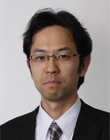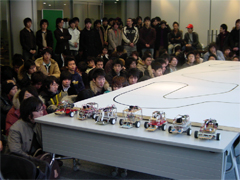Top>Education>Developing Gakushi Ryoku by "Triggering" Thought
 Index
Index

Akira Kubota [Profile]
Developing Gakushi Ryoku by "Triggering" Thought
Akira Kubota
Assistant Professor of Signal and Image Information Processing, Faculty of Science and Engineering, Chuo University
1. One definition of gakushi ryoku
When confronted with a new question in his or her major field, no university graduate would get away with answering, "I haven't learned about that, so I don't know." The graduate must understand the question, investigate the conditions, utilize the basic knowledge he or she has acquired over four years of study, and produce a solution to the best of his or her ability. Those who cannot do so are like people who cannot function without manuals, and they will most likely not be able to play an active role in society.
Until the end of high school, many students have had to devote themselves to exam preparation. As such, the focus of their education has been on training themselves to provide model answers, that is, to correctly solve the problems they are able to solve. If all the conditions for solving a problem are present, they are able to apply the methods they have learned and solve the problem. In the real world, however, it is rather more common for people to be confronted with problems for which all the conditions for solving them are not present. Moreover, in this fast-changing modern world, people are expected to be able to tackle problems even in fields of specialization somewhat different from their own. In addition, we now live in a time in which anybody anywhere in the world can instantaneously acquire information of practically equal quality, so the ability to solve diverse problems is being ever more emphasized.
Let us call the ability to utilize a basic foundation of knowledge to solve diverse problems gakushi ryoku, meaning undergraduate competency. Students appear to acquire this gakushi ryoku when something "triggers" them in their thinking. If we say that in reverse, students seek these "triggers" of thought. They hunger not only for the "What" (=knowledge), but also the "How" and "Why" (=the underlying ways of thinking).
2. Developing gakushi ryoku in lectures
When one hears the word "lecture," one might imagine an instructor silently writing on a blackboard while students copy the information in their notebooks. One might therefore get the impression that even if students attending the lecture can build up their foundations of basic knowledge, they will not be able to acquire the ability to solve diverse problems. In reality, however, such is not the case. To begin with, the basic knowledge taught in the lectures was, in fact, originally produced in order to solve problems. If one therefore turns one's attention to the background and principles which originally led to the production of this basic knowledge and follows the paths laid out by this background and principles, one will acquire the ability to solve problems.
In lectures, the author poses questions to the students in order to turn their attention to the aforementioned background and principles. By asking students specifically "how" and "why" something occurs, the author piques their interest in the problems, even if only a little. Once students are interested, they begin to think, and once they begin to think, they begin to follow the path. They ask themselves, "How would I solve this problem?" The author believes that this develops their ability to solve problems. From the podium, the author actually sees the students' eyes light up when they are asked these questions.
The author teaches the subject of signal processing, in which students are taught about processing techniques that produce signals (levels that change with the passage of time, such as audio signals). Fourier analysis is one of these processing techniques. Students can apply the analysis methods they've learned and mechanically solve various practice problems, but this is rather dry and boring. With such a dry method, students do not get the chance to taste the goodness of using Fourier analysis as a tool in signal processing. The author therefore presents them with questions such as, "There is a set of data composed of the sum of Data A and Data B in a certain ratio. What are the proportions of the respective sets of data?" Most students will wonder whether it is even possible to answer such a question. If the author then explains that, "(roughly speaking) If Data A and B have distinct properties, it is possible to solve this problem. One can use Fourier analysis as a tool to solve it," the students will be hooked. Getting the students to question and wonder "triggers" their thought processes.
3. The benefits of drill and experimentation
In addition to the regular classroom lectures, courses also include drills. Drilling entails solving concrete problems. In the Department of Electrical, Electronic, and Communication Engineering, in which the author works, students have five drilling sessions (450 minutes) every week in which they work on solving electrical and magnetic problems. By solving a large number of problems by themselves, it appears that students even begin to see the paths of logic that they were not able to understand in the lectures. Unfortunately, it seems that some students approach these problems like workers on an assembly line. They do, nevertheless, engage in high-level work, solving problems with imaginary numbers produced by imagining invisible electrical phenomena. This is something to be proud of, and such pride will undoubtedly also "trigger" thought.

The Contest
In addition to these drills, there are also experiments and contests. By experimenting and studying real phenomena, students can verify the information they've received in lectures. Moreover, students do not simply follow a manual in carrying out their experiments. They must present the points they have developed, and this as well becomes a "trigger" to make them think for themselves. In the contests, students compete over the speed and precision with which they operate small robots. Through trial and error, they must figure out how best to design the robots. Their competitiveness and sense of direction "trigger" them so that they think for themselves. Quite a number of the students stay up late at night to work on the designs for their robots, going far beyond the proscribed number of hours for the course. This course appears to be one of the most enjoyable for students.
4. Educational results of graduation research
Fourth-year students must undertake their graduation research. The author believes that this course develops their gakushi ryoku more than any other. Students must engage themselves with problems holding unknown solutions and write the best solutions they can in their senior theses. They must think continuously for an entire year. At the weekly seminar, they must explain the answers they have found up to that point to others who will in turn provide them with criticism. These experiences heighten the quality of their thinking. In addition, there are some research laboratories that take advantage of the availability of the Department of Science and Engineering's favored sites and hold joint seminars and presentations with neighboring universities. It is highly stimulating for students to give presentations in front of unfamiliar people who are in the same year and studying the same major field. Following these joint presentation seminars, there was an increase in the number of students in the author's laboratory who took the initiative in conducting their research. Many students also become concerned when the answers (data) they've produced are not good. The production of such poor data is, however, welcomed. This data becomes a treasure chest of ideas, and if students follow the routes provided by this data, they can approach much better answers. Thus, the students think one step further. The experiences gathered in conducting graduation research strengthen students' gakushi ryoku far more than expected.
- Akira Kubota
Assistant Professor of Signal and Image Information Processing, Faculty of Science and Engineering, Chuo University - Born in Oita Prefecture. Graduated from the Faculty of Engineering, Oita University in 1997. In 1999, he completed the graduate studies at the School of Engineering, Tokyo University and received his doctorate from the same faculty in 2002, when he also took a position as a special researcher at the Japan Society for the Promotion of Science. He traveled to Carnegie Mellon University in the Unites States in 2003 as a visiting researcher, and returned to Japan in 2004 when he took a position as a researcher at the High-Tech Research Center, Kanagawa University. In 2005, he became an assistant at the Interdisciplinary Graduate School of Science and Engineering, Tokyo Institute of Technology. He has been in his current position since 2009.
His research fields include creation techniques for image effects, the improvement of image resolution, compression coding, computer vision, and pattern recognition.
- Research Activities as a Member of Research Fellowship for Young Scientists (DC1), Japan Society for the Promotion of Science (JSPS) Shuma Tsurumi
- Important Factors for Innovation in Payment Services Nobuhiko Sugiura
- Beyond the Concepts of Fellow Citizens and Foreigners— To Achieve SDGs Goal 10 “Reduce Inequality Within and Among Countries” Rika Lee
- Diary of Struggles in Cambodia Fumie Fukuoka
- How Can We Measure Learning Ability?
—Analysis of a Competency Self-Assessment Questionnaire— Yu Saito / Yoko Neha - The Making of the Movie Kirakira Megane








